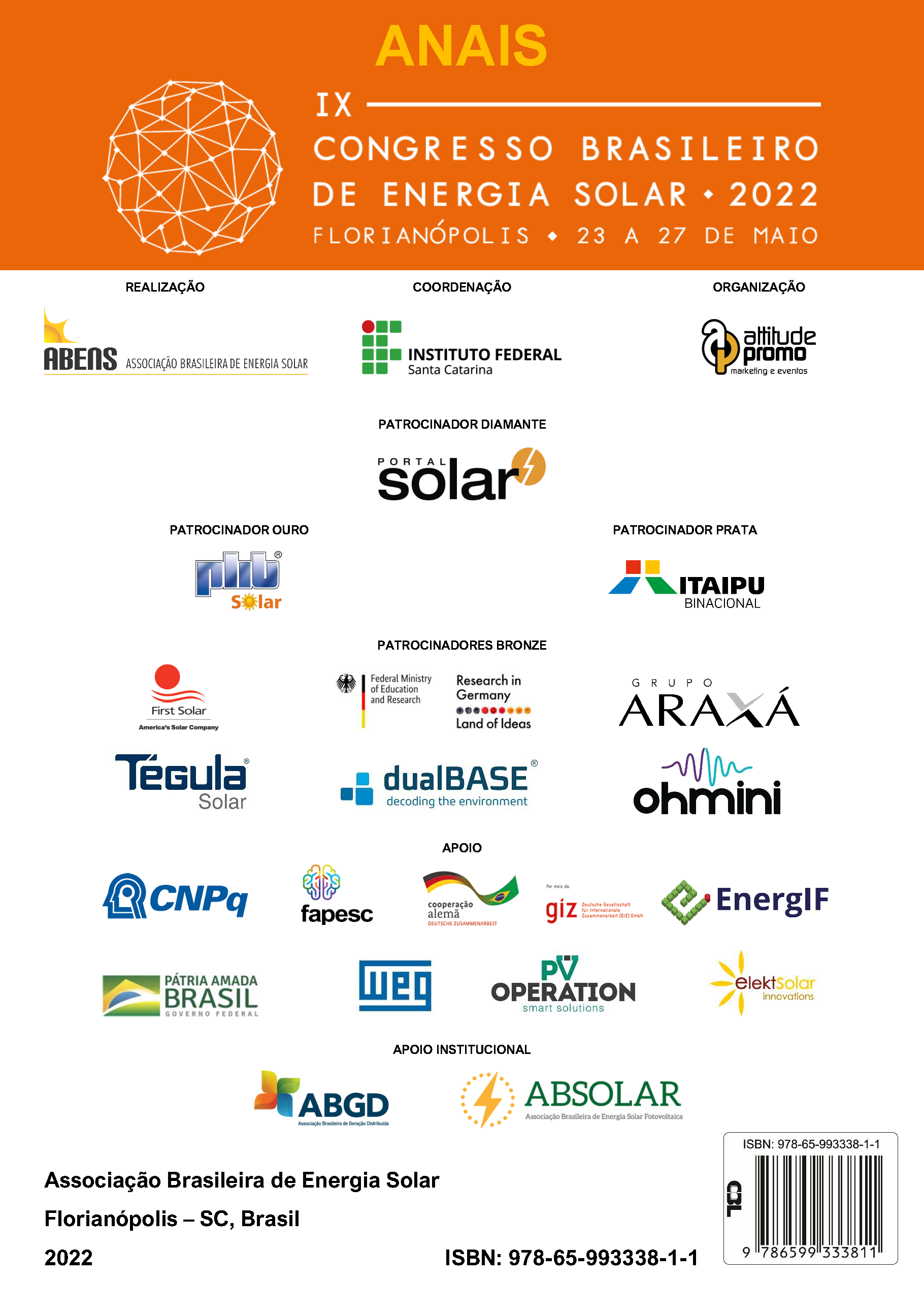DEGRADAÇÃO INDUZIDA POR POTENCIAL (PID) EM MÓDULOS FOTOVOLTAICOS
UMA BREVE REVISÃO
DOI:
https://doi.org/10.59627/cbens.2022.1175Palavras-chave:
Degradação de módulos, PID, Sistemas fotovoltaicosResumo
Os módulos fotovoltaicos (FV) em usinas de energia devem suportar altas tensões de polarização entre as camadas que compõem os módulos e a estrutura de montagem em que se encontram os módulos. Assim, esta alta tensão tem aumentado a degradação de módulos em campo prejudicando o desempenho do módulo fotovoltaico, ocasionando um grande problema para a indústria fotovoltaica. Este estresse de alta tensão resulta na degradação induzida por potencial (PID – potencial induced degradation). Neste artigo será fornecida uma revisão da literatura, tendo como objetivo fornecer uma visão geral das pesquisas que foram realizadas para a compreensão do PID e a situação atual da pesquisa sobre o tema para módulos FV de silício cristalino. Este artigo consiste em três partes. Na primeira parte, são discutidas as possíveis causas do PID e o mecanismo de como essa degradação atua nos módulos de silício cristalino (c-Si), examinando como a temperatura, umidade e tensão estão correlacionadas no avanço do PID. Na segunda parte são abordados os testes usados atualmente para a avaliar a durabilidade de módulos FV para PID. Na terceira parte são apresentadas medidas preventivas contra PID a nível de célula, módulo e sistema.
Downloads
Referências
Banerjee, S.; Das, M. K. Review of Rear Surface passivation in Passivated Emitter Rear Cell(PERC) using Different Process Technologies. 2020 National Conference on Emerging Trends on Sustainable Technology and Engineering Applications, NCETSTEA 2020, 1 fev. 2020.
Bora, B. et al. Accelerated stress testing of potential induced degradation susceptibility of PV modules under different climatic conditions. Solar Energy, v. 223, p. 158–167, 15 jul. 2021.
Carolus, J. et al. Physics of potential-induced degradation in bifacial p-PERC solar cells. Solar Energy Materials and Solar Cells, v. 200, p. 109950, 15 set. 2019.
Carolus, J. et al. Why and how to adapt PID testing for bifacial PV modules? Progress in Photovoltaics: Research and Applications, v. 28, n. 10, p. 1045–1053, 1 out. 2020.
Chen, D. et al. Hydrogen induced degradation: A possible mechanism for light- and elevated temperature- induced degradation in n-type silicon. Solar Energy Materials and Solar Cells, v. 185, p. 174–182, 1 out. 2018.
Dhere, N. G.; Shiradkar, N. S.; Schneller, E. Evolution of leakage current paths in MC-Si PV modules from leading manufacturers undergoing high-voltage bias testing. IEEE Journal of Photovoltaics, v. 4, n. 2, p. 654–658, mar. 2014.
Ferrara, C.; Philipp, D. Energy Procedia Energy Procedia 00 (2011) 000-000 International Conference on Materials for Advanced Technologies 2011, Symposium O Why Do PV Modules Fail? Energy Procedia, v. 15, p. 379–387, 2012.
Gu, Y. et al. Transformerless Inverter With Virtual DC Bus Concept for Cost-Effective Grid-Connected PV Power Systems. IEEE Transactions on Power Electronics, v. 28, n. 2, p. 793–805, fev. 2013.
Hansen, C. W. et al. Analysis of irradiance models for bifacial PV modules. 2017 IEEE 44th Photovoltaic Specialist Conference, PVSC 2017, p. 1376–1380, 2017.
Hara, K.; Jonai, S.; Masuda, A. Potential-induced degradation in photovoltaic modules based on n-type single crystalline Si solar cells. Solar Energy Materials and Solar Cells, v. 140, p. 361–365, 1 set. 2015.
Hoffmann, S.; Koehl, M. Effect of humidity and temperature on the potential-induced degradation. Progress in Photovoltaics: Research and Applications, v. 22, n. 2, p. 173–179, 1 fev. 2014.
Kumari, V. et al. Estimation of potential induced degradation in solar Mini-modules. Materials Today: Proceedings, v. 30, p. 229–233, 1 jan. 2020.
Kwembur, I. M. et al. Detection of Potential Induced Degradation in mono and multi-crystalline silicon photovoltaic modules. Physica B: Condensed Matter, v. 581, p. 411938, 15 mar. 2020.
Luo, W. et al. Elucidating potential-induced degradation in bifacial PERC silicon photovoltaic modules. Progress in Photovoltaics: Research and Applications, v. 26, n. 10, p. 859–867, 1 out. 2018.
Naumann, V. et al. Micro Structural Root Cause Analysis of Potential Induced Degradation in c-Si Solar Cells. Energy Procedia, v. 27, p. 1–6, 1 jan. 2012.
Naumann, V. et al. Microstructural Analysis of Crystal Defects Leading to Potential-Induced Degradation (PID) of Si Solar Cells. Energy Procedia, v. 33, p. 76–83, 1 jan. 2013.
Naumann, V. et al. Explanation of potential-induced degradation of the shunting type by Na decoration of stacking faults in Si solar cells. Solar Energy Materials and Solar Cells, v. 120, n. PART A, p. 383–389, 1 jan. 2014.
Nguyen, D. C. et al. Elucidating the mechanism of potential induced degradation delay effect by ultraviolet light irradiation for p-type crystalline silicon solar cells. Solar Energy, v. 199, p. 55–62, 15 mar. 2020.
Oh, W. et al. Initial detection of potential-induced degradation using dark I–V characteristics of crystalline silicon photovoltaic modules in the outdoors. Microelectronics Reliability, v. 88–90, p. 998–1002, 1 set. 2018.
Pingel, S. et al. Potential induced degradation of solar cells and panels. Conference Record of the IEEE Photovoltaic Specialists Conference, p. 2817–2822, 2010.
Singha, B.; Solanki, C. S. N-type solar cells: advantages, issues, and current scenarios. Materials Research Express, v. 4, n. 7, p. 072001, 5 jul. 2017.
Šlamberger, J. et al. Comparison of potential-induced degradation (PID) of n-type and p-type silicon solar cells. Energy, v. 161, p. 266–276, 15 out. 2018.
Solar Technology, S. A. Module Technology - SMA inverters provide the optimum solution for every module. [s.d.].
Suhaimi, F. Bin et al. Design, fabrication, and analysis of double-layer antireflection coatings (ARC) for industrial bifacial n-type crystalline silicon solar cells. Applied Optics, Vol. 58, Issue 15, pp. E1-E6, v. 58, n. 15, p. E1–E6, 20 maio 2019.
Wang, Q. Research on the effect of encapsulation material on anti-PID performance of 1500 V solar module. Optik, v. 202, p. 163540, 1 fev. 2020.
Wei Luo et al. Potential-induced degradation in photovoltaic modules: a critical review. Energy & Environmental Science, v. 10, n. 1, p. 43–68, 18 jan. 2017a.
Wei Luo et al. Potential-induced degradation in photovoltaic modules: a critical review. Energy & Environmental Science, v. 10, n. 1, p. 43–68, 18 jan. 2017b.


